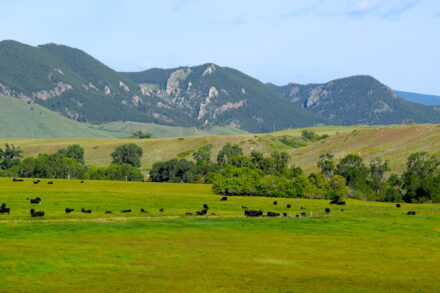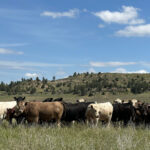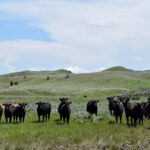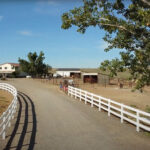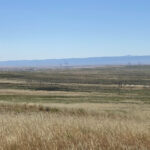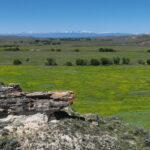The Backbone of Agriculture
Introduction
Alfalfa, a key component in Wyoming’s agricultural tapestry, is renowned for its robust forage production capacity, thriving in the state’s distinctive climatic and soil conditions. Its ability to yield abundantly without necessitating nitrogen fertilization sets it apart. The high levels of digestible energy and protein in alfalfa render it an indispensable feed resource in Wyoming’s livestock sector, notably reducing the reliance on expensive protein supplements. Furthermore, the presence of vital minerals like calcium, phosphorus, and magnesium in alfalfa contributes to lowering the costs associated with mineral supplements, thereby presenting a cost-efficient alternative for regional livestock farmers.
Historical Perspective and Contemporary Cultivation
The history of alfalfa in Wyoming stretches back to the 1800s, marking its significant presence in the state’s agriculture. The early 20th century witnessed a flourishing expansion of alfalfa farming, which later encountered challenges due to the emergence of the alfalfa weevil in the 1950s and the advent of affordable nitrogen fertilizers in the 1960s. These factors, coupled with pest invasions and the lack of alfalfa strains specifically bred for Wyoming’s unique environment, led to a downturn in alfalfa cultivation.
However, recent decades have seen a revitalized interest in alfalfa farming in Wyoming, spurred by escalating fertilizer and transportation costs, alongside a renewed emphasis on locally sourced forage production. This resurgence is underpinned by enhanced soil management and crop production techniques, as well as the availability of alfalfa varieties that are better suited to the regional climate and soil types. As a result, average alfalfa yields on farms now range between 3 and 4 tons per acre, with exceptional producers achieving even higher outputs. The University of Wyoming has been instrumental in this agricultural renaissance, offering a wealth of studies, publications, and training programs tailored to the specific agricultural needs of Wyoming.
Advancements in Alfalfa Research and Education
Alfalfa’s prominence in Wyoming has been significantly bolstered by extensive research and educational efforts. The University of Wyoming, along with other commercial entities and extension services, have been vital in propagating knowledge and best practices related to alfalfa cultivation. With the current trajectory and untapped potential, alfalfa’s future as a leading forage crop in Wyoming is bright. Its adaptability, augmented by recent scientific breakthroughs and research, positions it as an integral component of Wyoming’s agricultural vision. This is particularly relevant in the context of shifting economic conditions favoring sustainable agriculture, which has heightened the demand for high-quality forage. Consequently, alfalfa production is experiencing growth, supported by innovative research and development initiatives from the University of Wyoming in collaboration with private sector partners. These efforts focus on introducing new alfalfa varieties, creating more efficient harvest and curing systems, and fine-tuning production practices to align with Wyoming’s distinctive agricultural landscape. The culmination of these efforts is a marked improvement in the sustainability of alfalfa, in terms of yield, forage quality, and crop resilience within the state.
Alfalfa’s Multifaceted Role in Wyoming Agriculture
In Wyoming, the multifunctional nature of alfalfa is widely recognized and leveraged. It serves various purposes, such as pasture, hay, silage, or greenchop, and caters to the needs of diverse livestock sectors, including dairy and beef cattle, sheep, goats, and the burgeoning equine industry. This multifunctionality extends to supporting the growing demand for grass-fed meat and dairy products. Alfalfa’s adaptability, coupled with its high yield and quality, secures its position as a fundamental component in Wyoming’s livestock feeding programs. Beyond its role as a profitable cash crop, alfalfa is pivotal in crop rotation schemes, enhancing soil fertility, structure, and overall health.
Alfalfa’s Integral Role in Crop Rotation Systems
Alfalfa’s contribution to enhancing soil health and fertility in Wyoming, especially in crop rotation contexts, is substantial. When integrated into crop rotations, alfalfa can infuse over 100 pounds of nitrogen per acre into the soil, offering significant benefits to subsequent crops. This nitrogen-fixing capacity of alfalfa is a key advantage in sustainable agricultural practices. The deep-rooted nature of alfalfa serves multiple purposes: it aids in creating soil channels that enhance deeper root penetration for following crops, improves soil structure, and boosts water infiltration and soil stability. The inclusion of alfalfa in crop rotations has demonstrated considerable advantages. For example, research has shown that corn yields can increase by 10-15% when grown following an alfalfa crop, attributed to the enhanced soil conditions and reduced pest presence often observed in fields previously sown with alfalfa. In scenarios where continuous cultivation of crops like corn is challenging, such as on steep terrains, rotating silage corn with alfalfa (either in strips or across entire fields) has proven to yield higher forage outputs compared to other crop rotation systems.
Moreover, alfalfa’s impact extends beyond the period of its active growth. A typical rotation cycle of 3 to 5 years allows farmers to maximize alfalfa’s peak productivity phases. After this period, the land can be either plowed or prepared for no-till planting of the next crop. This practice is crucial as alfalfa stands tend to become more susceptible to diseases and weed infestations over time. To circumvent issues where mature alfalfa plants can hinder the growth of new alfalfa seedlings (allelopathy), it is recommended not to replant alfalfa in the same field for at least a year after the previous crop.
In addition to its agronomic benefits, alfalfa also contributes significantly to soil conservation. Its root system plays a vital role in mitigating soil erosion, a common challenge in agricultural lands, especially those with steep slopes. The effectiveness of alfalfa in reducing soil loss is notable when compared to other crops. For example, on fields with a 5% slope extending 200 feet, the average soil loss per acre can be significantly higher for crops like soybeans, corn, or grain sorghum, and wheat, ranging from 8 to 35 tons. In contrast, alfalfa’s soil loss typically ranges between 2 to 4 tons per acre, highlighting its efficacy in soil preservation.
Soil loss comparisons per acre per year:
- Soybeans – 14 to 35 tons
- Corn or grain sorghum – 13 to 25 tons
- Wheat – 8 to 13 tons
- Alfalfa – 2 to 4 tons
Alfalfa Cultivation in Wyoming
For alfalfa cultivation to be profitable in Wyoming, it is essential to focus on achieving high forage yields, maintaining the longevity of the crop, and employing effective sales strategies. This requires detailed planning, prompt actions, and strategic management. The foundational elements for thriving alfalfa growth include:
- Choosing the Right Location: Opt for areas with good drainage to support a strong root system.
- Nutrient Management and Pest Control: Actively manage soil nutrients and pests, including timely applications of fertilizers and pest control measures.
- Harvesting at the Right Time: Ensure that you can harvest alfalfa when it is most suitable.
- Efficient Sales Tactics: Create and implement effective strategies for selling or using the alfalfa.
In Wyoming, the diverse soil and weather conditions mean that broad guidelines are more useful than specific instructions. These guidelines draw from extensive research and the experiences of local growers. For comprehensive guidance on seed varieties, soil nutrition, planting, pest control, and harvest management, the University of Wyoming (UW) is an invaluable resource.
Choosing a Suitable Site
Alfalfa requires well-drained soil for optimal growth and longevity. Poor drainage may lead to diseases like root rot and winter heaving. Despite advancements in variety development, varieties resistant to waterlogged conditions are limited. Soil mapping can help identify ideal locations for alfalfa farming. Terrain safety and machinery operation should also be considered. In Wyoming, areas with high water tables or shallow impediments like bedrock are less favorable. Acidic soils in mountainous or high-precipitation areas may need lime treatment to adjust soil pH for alfalfa, which prefers neutral to slightly alkaline soil. Testing subsoil acidity to a depth of 4 feet, ensuring pH levels are above 5.5, is recommended.
Soil Analysis and Fertilization
Soil testing is a cost-effective way to identify specific fertilization needs, guiding the application of lime, phosphorus, and potassium. Post-harvest plant analysis can further refine fertilization strategies. Alfalfa thrives when soil pH is between 6.5 and 6.8. In areas where nitrogen fixation is reduced due to low pH, adding micronutrients might be necessary.
Nurturing established alfalfa
Keeping soil fertility high is vital for healthy alfalfa crops. While nitrogen may not be needed for well-nodulated stands, applications of lime, phosphorus, potassium, and other micronutrients are crucial. Regular soil tests are advised to maintain and adjust fertility levels. As alfalfa is a heavy nutrient consumer, replenishing nutrients, especially potassium in mixed stands, is often necessary.
Selecting the Right Variety
The choice of alfalfa variety is critical for yield, quality, and longevity. Look for varieties that are high-yielding, pest-resistant, and suited to Wyoming’s conditions. Diversifying varieties on larger farms can be advantageous. UW and private entities are continuously developing new varieties specifically for Wyoming’s agricultural environment.
Seed Inoculation
Using pre-inoculated alfalfa seeds, often coated with lime, streamlines the planting process and ensures proper inoculation. If the coating is compromised or the seeds have been improperly stored, re-inoculation may be needed. Store inoculants away from direct sunlight and heat, and follow label instructions closely for best results.
Planting Techniques
Successful alfalfa planting requires a well-prepared seedbed. Preparing the soil in advance allows for effective incorporation of nutrients. The seed should be planted at the correct depth for the soil type. Both traditional tilled seedbeds and no-till methods are viable. No-till drilling into dormant vegetation helps reduce erosion and conserve moisture but requires careful management of existing vegetation and soil health.
Managing Weeds
Healthy, dense alfalfa stands naturally inhibit weed growth. Proper cutting practices also play a role in weed control. A range of herbicides is available for different weed species in alfalfa. Weeds are particularly problematic during the establishment phase. Pre-plant herbicides control grassy weeds, while additional post-emergence treatments may be needed for broadleaf weeds. In alfalfa-grass mixtures, plant grass in established alfalfa during late summer or fall. Effective weed management and harvesting techniques are crucial for maintaining alfalfa quality and yield in Wyoming.
Controlling Pests
Effective insect control is key to preserving alfalfa yield and quality. Managing pests like alfalfa weevil and potato leafhopper is critical. Strategies include using resistant varieties, regular field monitoring, biological control methods, and selective insecticide use.
Disease Management
In Wyoming, several diseases can significantly impact alfalfa crops. Key diseases that should be on one’s radar include:
- Bacterial Wilt: This disease, caused by Clavibacter michiganensis subsp. insidiosus, leads to leaf yellowing, wilting, and stunted growth, eventually killing the plant. The bacterium can persist in fields for many years.
- Anthracnose: A fungal disease by Colletotrichum trifolii, it presents as lesions on stems, leaves, and crowns, reducing yield and thinning stands, especially in moist conditions.
- Phytophthora Root Rot: Phytophthora megasperma fungus attacks alfalfa roots, causing decay and stunted growth. It’s exacerbated in wet, poorly-drained soils.
- Leaf Spot Diseases: Diseases like common leaf spot and Leptosphaerulina leaf spot cause spots on leaves, reducing photosynthesis and overall plant health.
- Verticillium Wilt: Verticillium albo-atrum fungus causes leaf yellowing and wilting, significantly affecting yield and stand longevity.
- Sclerotinia Crown and Stem Rot: Also known as white mold, caused by Sclerotinia sclerotiorum, it results in rot at the crown and stem bases, thriving in cool, wet conditions.
- Aphanomyces Root Rot: This disease affects seedling alfalfa, leading to root rot and yellowing foliage.
- Fusarium Wilt: Fusarium oxysporum causes leaf yellowing and wilting, reducing plant health and yield.
Managing these diseases involves using resistant varieties, crop rotation, proper drainage, and maintaining field hygiene. Regular monitoring and timely action are essential.
Strategies for disease management in alfalfa:
- Choose certified seeds from recommended, disease-resistant varieties.
- Avoid planting alfalfa in fields previously used for alfalfa or clover within two years.
- In Wyoming, aim for summer seedings before mid-August to promote pre-winter growth.
- Ensure plants reach 6-8 inches before winter for adequate root energy reserves.
- Follow best practices for liming, fertilizing, planting, and cutting.
- Implement insect control to reduce plant stress and disease vulnerability.
Maximizing Alfalfa Harvesting Techniques
In Wyoming, alfalfa is mainly harvested for hay, but also as silage, baleage, or greenchop. Silage and baleage, especially from spring growth, are advantageous due to easier mechanization and higher feed quality preservation. These methods minimize leaf loss and mitigate rain damage risks, proving more efficient than traditional hay production.
Under ideal conditions, alfalfa can be mowed, chopped, and processed into silage or baleage on the same day. Research supports the use of chemical preservatives and microbial inoculants to safely store hay at higher moisture levels. These products, increasing hay production flexibility, are widely available.
Harvest timing in Wyoming varies due to climate differences and may need adjustments for optimal yield, quality, and alfalfa stand persistence. Alfalfa nutritional value declines from the vegetative to flowering stage, although yields increase. Harvesting frequently in the vegetative stage can shorten stand life. Harvesting during late bud or early bloom balances high-quality feed production with stand longevity.
High-quality alfalfa hay typically contains 17-20% crude protein (CP) and 60-65% total digestible nutrients (TDN). In nutritional terms, six tons of quality alfalfa hay surpasses the energy of 150 bushels of corn and the protein of 2 tons of soybean meal. The ultimate measure of forage quality is animal performance, where taste and the balance of energy and protein are crucial. Alfalfa enhances livestock intake, even with low-quality forages. Harvest management, especially timing and leaf preservation, greatly influences forage quality.
Optimizing alfalfa’s qualities:
- Maturity Stage at Harvest: The maturity stage significantly influences forage quality. Managing the transition from vegetative to reproductive stages is key, as later stages have higher fiber and lower protein content and palatability.
- Leaf Content: Leaves are richer in fiber digestibility, protein, energy, and minerals than stems. Therefore, minimizing leaf loss during harvesting processes is essential for maintaining alfalfa quality.
- Forage Color: Bright green color indicates proper curing and high carotene, affecting palatability. Some discoloration, due to sunbleaching or mild rain damage, does not significantly impact quality.
- Scent and Texture: Freshly mowed hay scent is a quality indicator. Musty or rotten smells suggest poor quality, affecting palatability and market value, particularly in the horse industry. Such odors often result from adverse weather during curing or baling or storing at inappropriate moisture levels.
Utilizing Alfalfa for Grazing
In Wyoming, the practice of grazing alfalfa, previously less common, is gaining traction among livestock producers, especially those focused on grass-fed meat and dairy. Alfalfa, alone or in mixtures with grass, provides excellent pasture quality, meeting the needs of modern grazing systems. Its high forage quality contributes to significant weight gains in beef stocker and finishing operations, often surpassing 2.5 pounds daily. Implementing managed grazing, like rotational stocking, is key to maximizing alfalfa’s productivity. This involves grazing alfalfa at the bud or early bloom stage down to a stubble height of 2 to 4 inches, followed by a rest period of 25 to 30 days. The initial grazing cycle in the season can be challenging due to rapid growth, requiring early grazing and setting aside some paddocks for later use either for hay or grazing.
For optimal grazing benefits, selecting alfalfa varieties resistant to grazing is recommended. Recent developments in temporary fencing and portable water systems have made controlled grazing more accessible and cost-effective, improving forage management and reducing waste. In a well-managed system, rotating livestock among smaller, numerous pastures improves forage utilization efficiency.
Creep grazing systems, particularly useful when combining mature animals with lower nutrient needs (like beef cows) with those requiring higher nutrients (such as nursing calves), also benefit from alfalfa. Affordable structures like creep gates enable calves to access alfalfa pastures, limiting cow movement.
However, grazing alfalfa poses a bloat risk in ruminants, particularly when introduced to lush stands while hungry. To mitigate this, ensure animals are not hungry when entering new paddocks, introduce them during late morning or early afternoon after dew has evaporated, and consider interseeding with cool season grasses in older stands to reduce bloat risk and improve forage production. In high-risk scenarios, feeding energy supplements with monensin or bloat preventatives like poloxalene may be necessary.
Alfalfa for Wildlife Forage
Alfalfa is a favored forage for wildlife, with increasing cultivation for deer and other animals. The advent of grazing-tolerant alfalfa varieties has enhanced its suitability for continuous grazing, making it ideal for wildlife food plots.
Alfalfa offers high forage quality and palatability, strong dry matter yield, and drought tolerance for wildlife, similar to its benefits for livestock. Its extended growing season ensures a steady forage supply throughout the year. Alfalfa fields also support various bird species by providing a rich protein source in the form of insects.
While alfalfa requires more precise planting and higher soil pH management compared to other wildlife plants, its nutritional benefits, including increased body weight, improved breeding, and enhanced antler development in deer, are significant. Wildlife enthusiasts incorporating alfalfa into habitats, adhering to essential agronomic principles, have reported considerable success.
Economic Considerations and Marketing Strategies
Alfalfa’s Growing Demand in Wyoming
The rising costs of supplemental feeds and transportation in Wyoming emphasize the value of high-quality, locally produced forage, positioning alfalfa as an attractive option. Advances in alfalfa varieties, harvest, and curing systems, along with refined production practices, have made alfalfa cultivation increasingly viable across the state.
Evaluating Alfalfa Production Costs and Benefits
Wyoming farmers contemplating alfalfa should assess the costs against potential returns. Resources from land-grant universities like the University of Wyoming offer online tools for alfalfa production budgeting. These tools consider moderate soil fertility levels and initial investments in lime and fertilizers. Costs vary based on soil fertility and lime responsiveness, with annual expenses covering soil fertility, yield, harvesting methods, and pest and disease management. Customized budgets for specific situations are recommended for each unique alfalfa production system.
Enhancing Alfalfa’s Return on Investment
Understanding the return on investment is crucial for Wyoming farmers growing alfalfa. Known for its high forage quality, with over 16% crude protein and 60% total digestible nutrients (TDN), alfalfa’s economic advantage lies in high yields and extended stand life. Effective management strategies are essential for maximizing yields and prolonging alfalfa’s lifespan, offsetting initial establishment costs and fixed expenses.
Diversifying Alfalfa Marketing Approaches
Not all alfalfa harvests in Wyoming meet premium hay market standards. For harvests with lower quality, such as those with excessive weeds or damage, diversifying marketing strategies is key. This may involve selling lower-grade hay to neighboring farms or using it in the producer’s own livestock diet. A diversified marketing approach ensures economic resilience and stability for alfalfa farmers.
Conclusion
The increasing importance of alfalfa in Wyoming’s agriculture reflects its status as a high-quality forage crop. This resurgence is driven by research and technological advancements, with entities like the University of Wyoming and the private sector leading the development of new alfalfa varieties and harvesting methods. These innovations, tailored to Wyoming’s unique environmental challenges, are crucial for maintaining high yields and quality, vital for the state’s agricultural success. Efforts to address challenges such as the alfalfa weevil and the introduction of locally adapted seed varieties have been instrumental in advancing alfalfa production. Successful cultivation in Wyoming’s diverse environmental conditions demands customized strategies, including regular soil tests, targeted fertilization, and the selection of high-yielding, pest-resistant alfalfa varieties. Alfalfa’s adaptability, nutritional benefits, and positive impact on soil health make it a valuable option for Wyoming farmers. Continued research, innovative practices, and effective farm management are expected to further enhance alfalfa’s role in Wyoming’s agriculture, solidifying its significance as a key crop. For Wyoming farmers, alfalfa offers significant potential as a lucrative agricultural pursuit, bolstered by ongoing developments in its cultivation.


